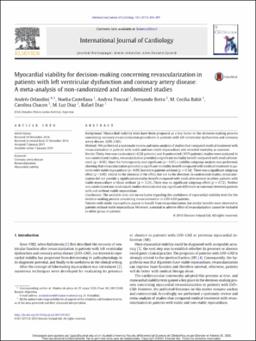| dc.description.abstract | BACKGROUND:
Myocardial viability tests have been proposed as a key factor in the decision-making process concerning coronary revascularization procedures in patients with left ventricular dysfunction and coronary artery disease (LVD-CAD).
METHODS:
We performed a systematic review and meta-analysis of studies that compared medical treatment with revascularization in patients with viable and non-viable myocardium and recorded mortality as outcome.
RESULTS:
Thirty-two non-randomized (4328 patients) and 4 randomized (1079 patients) studies were analyzed. In non-randomized studies, revascularization provided a significant mortality benefit compared with medical treatment (p<0.05). Since the heterogeneity was significant (p<0.05) a viability subgroup analysis was performed, showing that revascularization provided a significant mortality benefit compared with medical treatment in patients with viable myocardium (p<0.05) but not in patients without (p=0.34). There was a significant subgroup effect (p<0.05) related to the intensity of the effect, but not to the direction. In randomized studies, revascularization did not provide a significant mortality benefit compared with medical treatment in either patients with viable myocardium or those without (p=0.21). There was no significant subgroup effect (p=0.72). Neither non-randomized nor randomized studies demonstrated any significant difference in outcomes between patients with and without viable myocardium.
CONCLUSIONS:
The available data are inconclusive regarding the usefulness of myocardial viability tests for the decision-making process concerning revascularization in LVD-CAD patients. Patients with viable myocardium appear to benefit from revascularization, but similar benefits were observed in patients without viable myocardium. Moreover, a neutral or adverse effect of revascularization cannot be excluded in either group of patients.
Copyright © 2015 Elsevier Ireland Ltd. All rights reserved. | en_US |


